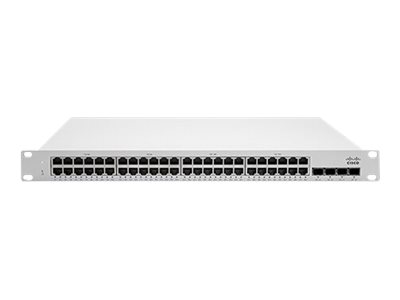Description
CLOUD-MANAGED STACKABLE ACCESS SWITCHES
Cisco Meraki MS210 switches provide Layer 2 access switching for branch and small campus locations. The MS210 includes 4 x 1G SFP uplinks and physically stacks with the MS225 to gain access to its 10G uplink. This family also supports an optional, rack-mountable PSU (Cisco RPS-2300) for power redundancy requirements.
Cisco Meraki switches are built from the ground up to be easy to manage without compromising any of the power and flexibility traditionally found in enterprise-class switches.
The Meraki MS is managed through an elegant, intuitive cloud interface, rather than a cryptic command line. To bring up a Meraki switch, just plug it in; there’s no need for complicated configuration files or even direct physical access to the switch.
Meraki’s centralized management gives administrators deep visibility into the network and how it’s used. See which switches are near capacity across hundreds of sites. Find all configuration changes made by a certain person with instant search.
INDUSTRY LEADING CLOUD MANAGEMENT
Cloud management has a number of benefits that make it easier to build networks large and small:
- True zero-touch device provisioning.
- Virtual stacking: manage up to thousands of ports from a single pane of glass.
- Application layer visibility with automatic operating system, client, and hostname fingerprinting.
- Powerful Live Tools such as packet capture and cable test to isolate and troubleshoot network issues.
- Alerts upon power loss, downtime, or configuration changes.
- Role-based administration and automatic, scheduled firmware upgrades over the web.
- Regular feature updates and enhancements delivered on demand from the Meraki cloud.
Product Highlights
- Access to 10G uplink by physically stacking with the MS225
- Gigabit Access switching with 24 and 48 port models and optional PoE+
- 4 x 1G SFP uplink interfaces on all models
- Built-in dual stacking interfaces with up to 80G bandwidth
- Non-blocking switch backplane with up to 176 Gbps bandwidth support
- Up to 740 watt PoE budget with PoE+ support and dynamic power allocation for powering APs, phones, cameras, and other PoE-enabled devices
- 8 dedicated QoS queues for converged voice, video, and data applications
- Low power consumption and shallow rack depth options, enabling flexible deployment in wiring closets as well as offices and classrooms
- Integrated mounting brackets for rack and desk mounting
- Lifetime hardware warranty and advanced replacement at no additional cost
Features
Meraki switches include all of the traditional Ethernet features found in modern enterprise access switches, including:
Branch & Campus Access
- Physical stacking with support for up to 8 stack members for built-in redundancy, performance, and access to 10Gbps uplinks when stacked with an MS225 switch
- Quality-of-Service (QoS) to prioritize mission critical traffic such as voice and video
- Voice VLAN support for simplified VoIP deployments
- CDP, LLDP advertisement and snooping, with detailed neighbor discovery and visibility
- Port Mirroring support for monitoring network traffic at line rate
- IGMP Snooping to optimize network performance for multicast applications
- Link Aggregation Control Protocol (LACP) for high-capacity trunking, with Multichassis (MLAG) support on stacked switches
Network Security
- IEEE 802.1X, MAB, and Hybrid authentication support for wired access control with RADIUS server monitoring
- Port security and MAC whitelisting
- Change of Authorization (CoA) and RADIUS accounting support
- DHCP snooping to prevent users from adding unauthorized DHCP servers on the network
- Rapid spanning tree, BPDU guard, root guard, and other safeguards to help prevent misconfigurations and reduce convergence time
- Per port VLAN configuration
- Multiple administrative roles with sophisticated security policy management
Network Troubleshooting & Automation
- Virtual Stacking lets administators manage up to thousands of ports in a single interface without having to physically connect stack members
- Configuration templates for rapid, zero-touch provisioning and auditing of all sites
- Network Topology for automatic and interactive network mapping
- Remote cable testing, packet capture and client discovery
- Automatic and scheduled firmware upgrades for the complete network
Converged Voice, Video and Data Environments
The Meraki switch family is designed to unify data, voice, and video onto a single IP backbone. All Meraki switches support rich qualityof-service (QoS) functionality for prioritizing data, voice, and video traffic. The switches support eight class-of-service (CoS) queues on every port, enabling them to maintain end-to-end traffic prioritization.
PoE models provide power VoIP telephones, IP security cameras, wireless access points (APs), and other IP devices. In addition, using CDP and LLDP, PoE power is intelligently budgeted to maximize the number of PoE clients supported. For the most power-hungry applications, support for Cisco UPoE is also available. The Meraki MC products work flawlessly with Meraki switches, and create a unique and powerful experience to installing, supporting and troubleshooting VoIP technology.
Application Layer Visibility
Meraki is the only switch to include integrated Layer 7 fingerprinting. Identify hundreds of applications from business apps to BitTorrent and YouTube. User fingerprinting with Google-like search allows administrators to easily identify and control individual users, PCs, iMacs, iPads, Androids, and other devices. This unprecedented visibility allows optimizing of network resources and maintaining optimal network performance.
Unified Software Architecture
Meraki switches run the same Meraki operating system used by all of Meraki’s products. The use of a common operating system allows Meraki to deliver a consistent experience across all product lines. When connected, MS210 switches automatically connect to the Meraki cloud, download configuration, and join the appropriate network. If new firmware is required, this is retrieved by the switch and updated automatically. This ensures the network is kept up-todate with bug fixes, security updates, and new features.

